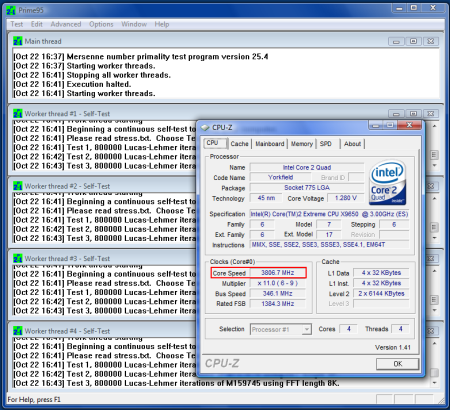Intel's 45 nm Penryn CPU: 4 GHz Air Cooled
Overclocking III - 3.8 GHz
In our quest to find the maximum clock speed of our QX9650, we next attempted to get it to run stably at 3.8 GHz. Since the original FSB of this CPU runs at 333 MHz (1333 QDR) and our X38 board made by Gigabyte did not support half-step multipliers at the time of testing, we weren't able to get to 3.8 GHz using the multiplier. Therefore, we stayed at 11x and increased the FSB to 346 MHz (1384 QDR).
To ensure that the processor was stable at 3.8 GHz, we had to increase the core voltage a little more. At 1.3375 V - 0.0975 V over the stock voltage - the QX9650 passed Prime95's torture test.
Using a core voltage that is the default for the 65 nm generation of Core 2 processors, the new 45 nm version operates at 27% over its stock clock speed. Here we see that the thermal dissipation loss does not increase too much as a result of overclocking.
The QX9650 was stable at 3.8 GHz with a voltage increase of 7% over its default value.
Booting at 3.8 GHz
Get Tom's Hardware's best news and in-depth reviews, straight to your inbox.
Current page: Overclocking III - 3.8 GHz
Prev Page Overclocking II - 3.66 GHz Next Page Overclocking IV - 4 GHz At Very High VoltageTom's Hardware is the leading destination for hardcore computer enthusiasts. We cover everything from processors to 3D printers, single-board computers, SSDs and high-end gaming rigs, empowering readers to make the most of the tech they love, keep up on the latest developments and buy the right gear. Our staff has more than 100 years of combined experience covering news, solving tech problems and reviewing components and systems.



